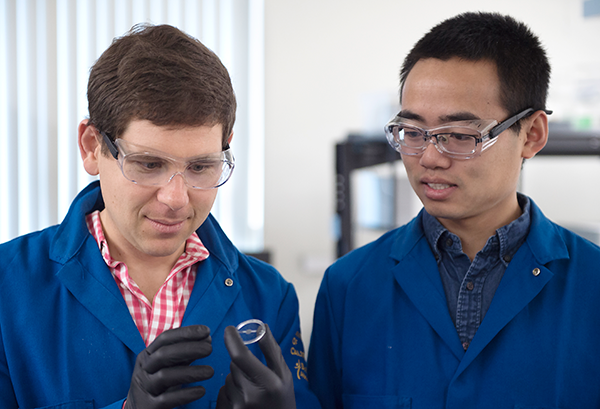UCI Engineers Develop Squid-inspired Multimodal Camouflage System
Technology suited for military application

Alon Gorodetsky (left) and Chengyi Xu are developing the next generation of high-tech bioinspired camouflage systems. Steve Zylius / UCI
March 23, 2020 - UC Irvine engineering researchers have made significant progress in their efforts to develop the next generation of high-tech bioinspired camouflage systems by developing and leveraging a material that is electrically conductive, optically transparent and mechanically stretchable. This material’s unique combination of properties makes it ideal for applications in state‐of‐the‐art concealment technologies for the military.
Alon Gorodetsky, associate professor of chemical and biomolecular engineering at the Samueli School, and materials and engineering graduate student Chengyi Xu detailed their findings in a March issue of Advanced Materials.
According to Gorodetsky, soft deformable systems that can, on demand, manipulate light within both the visible and infrared regions of the electromagnetic spectrum are needed for applications that include sensing, optoelectronics, robotics, energy conservation and thermal management. But they have been challenging to engineer.
Drawing inspiration from the way cephalopods change shape and color and interact with light, the engineering researchers have developed a tri‐layer system made of soft polymer membranes and sticky tape, in which the sizes, thicknesses and surface microstructures of the material are reconfigured across multiple length scales by mechanical stimuli. Systems using this material as electrodes were able to transform from wrinkled opaque to transparent when either pulled manually or zapped with voltage. In a demonstration using Vincent van Gogh’s famous Starry Night painting as the backdrop, the systems effectively disappeared and reappeared under both visible and infrared detection systems, responding quickly and with good stability when actuated electromechanically.
“The optimized material worked very well as an electrode in our devices and it also allowed them to function in both the visible and the infrared,” Gorodetsky said.
They discovered that the material could stretch by 500 percent, at which point one would expect its charge conduction ability to degrade. Many electrically conducting materials, such as metals and conductive rubbers, can’t be stretched that far without deleteriously changing their properties or breaking. The engineered material, on the other hand, remained stable.
“We discovered that the stretchability of the material was one of the factors that allowed the devices to work so well,” said Gorodetsky. “It doesn’t lose conductivity when you stretch it up to five times its length, and it has many great properties. So, it let us fabricate adaptive multimodal camouflage devices that work in both the visible and the infrared. That’s extremely rare and difficult to do as effectively as we did over such a large spectral window.”
Other potential applications include smart windows, bioelectronics, artificial skin and soft robotics.
“Finding a soft material with an excellent combination of optical, mechanical and electrical properties is quite difficult and will certainly have much scientific and technological value,” said Xu. “Multispectral camouflage is only one possible application among many exciting potential directions that are enabled by this electrically conducting polymer material.”
– Lori Brandt
